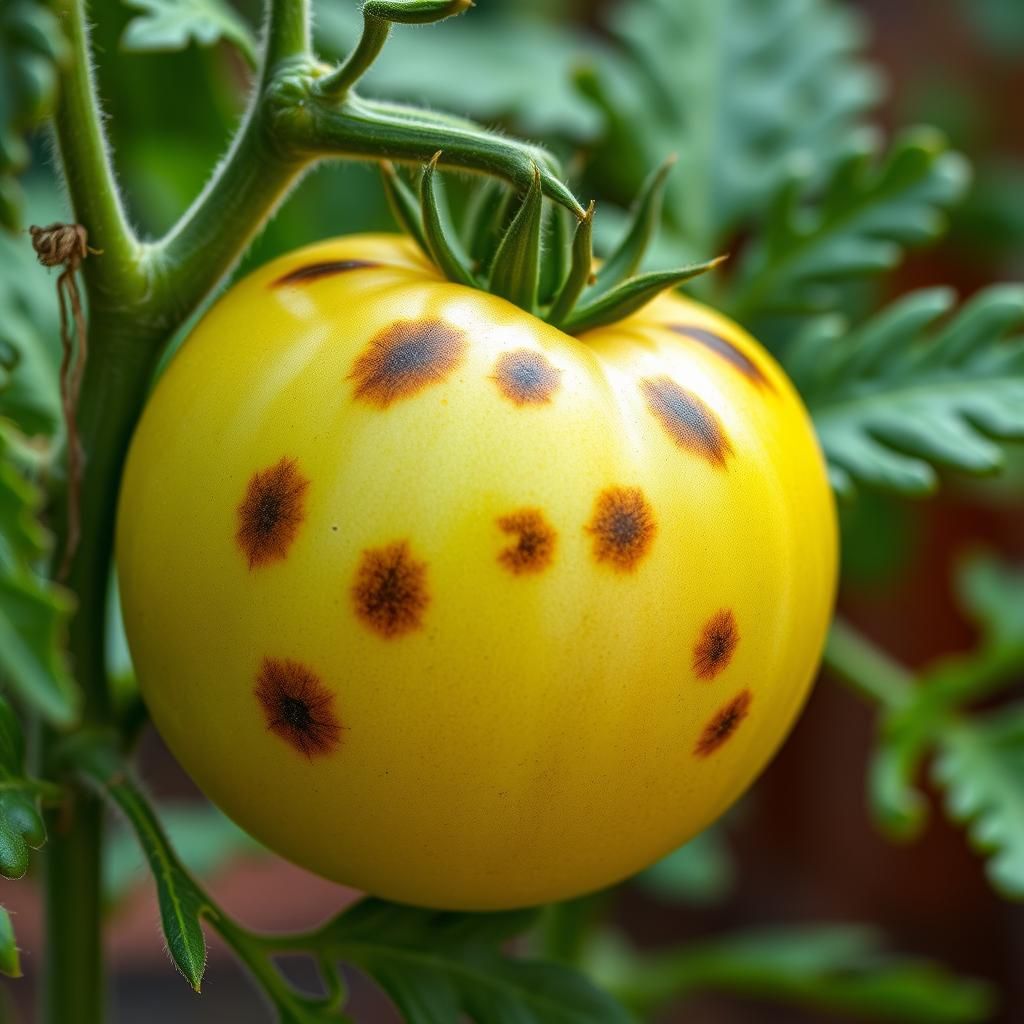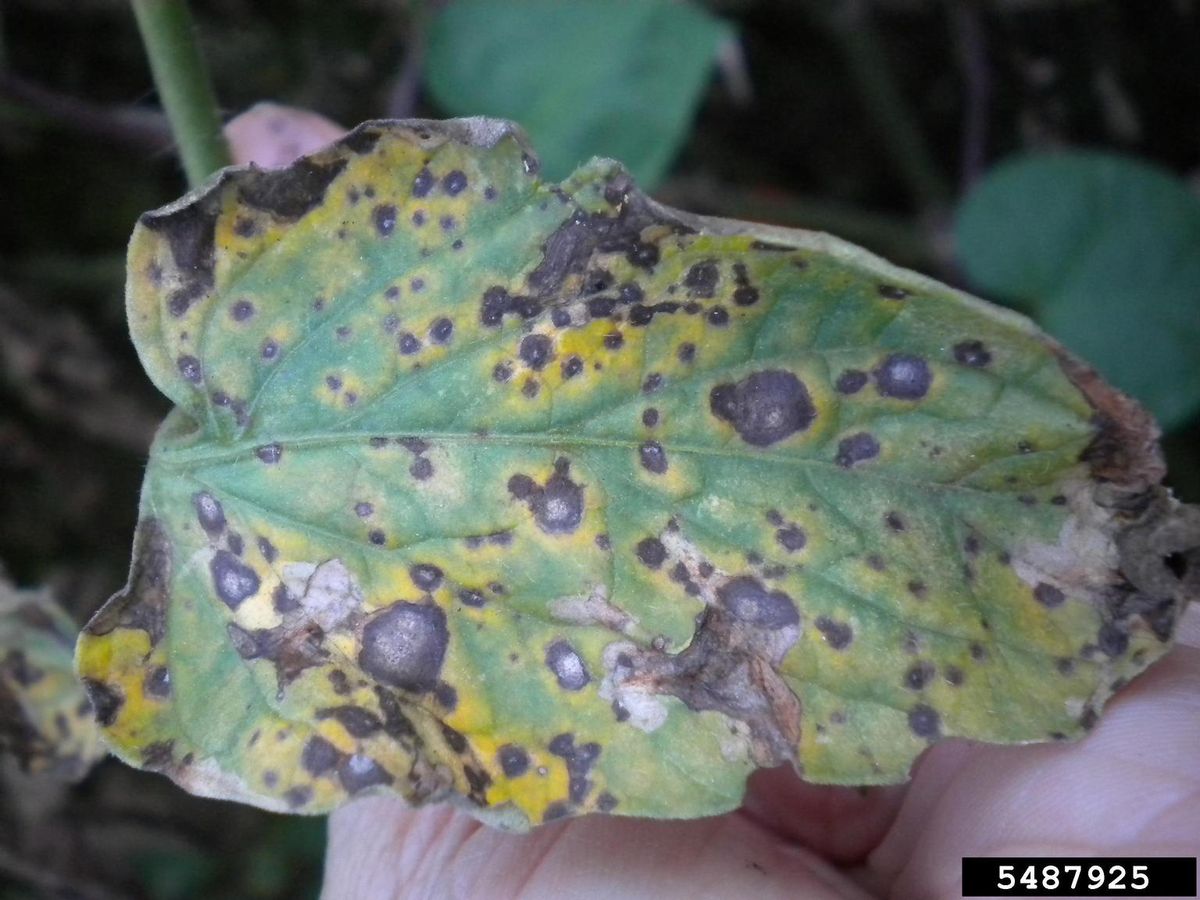How to Identify and Treat Black Spots on My Tomato Plants: A Comprehensive Guide

Tomato plants are a beloved staple in gardens, but they can be susceptible to various diseases and pests. One common issue that many gardeners encounter is the appearance of black spots on their tomato plants. These unsightly marks can indicate a range of problems, from fungal infections to nutrient deficiencies. Understanding how to identify the cause of these spots is crucial for ensuring the health of your plants. This comprehensive guide will provide you with the insights needed to recognize the signs, diagnose the issues accurately, and apply effective treatments to restore your tomato plants to thriving condition.
Understanding Black Spots on Tomato Plants
Black spots on tomato plants can be a sign of various issues, ranging from fungal infections to nutrient deficiencies. One of the most common causes is a disease known as early blight, caused by the fungus Alternaria solani, which manifests not only as black spots but also leads to yellowing of the leaves. Other potential causes may include bacterial spots, viral infections, or even physiological conditions related to environmental stress, such as excessive moisture or poor air circulation. Identifying the precise cause of these black spots is crucial to effectively addressing the problem and ensuring the healthy growth of your tomato plants.
Common Diseases Causing Black Spots
Several diseases can lead to the development of black spots on tomato plants, with early blight being one of the most prevalent. It first presents as small, dark spots on the leaves, which eventually expand and can cause significant damage to the foliage. Other notable diseases include Septoria leaf spot and bacterial spot, both of which also produce noticeable black lesions on leaves. Proper disease identification is key to applying the right treatment.
Nutrient Deficiencies
Nutrient deficiencies can also manifest as black spots on tomato plants, particularly a deficiency in potassium or magnesium. When these essential nutrients are lacking in the soil, the plants may exhibit signs of distress, including dark spots on leaves and poor overall growth. Conducting a soil test can help determine the nutrient levels and guide fertilization practices to restore balance.
Pest Infestations
Certain pests can contribute to the appearance of black spots on tomato plants. Insect damage, particularly from the tomato hornworm or aphids, can cause the leaves to become discolored, leading to black spots as a secondary issue from stress or disease. Regular monitoring and pest control measures are essential to mitigate their impact on the plants.
Environmental Factors
Environmental factors play a significant role in the health of tomato plants and can lead to black spots. High humidity, poor air circulation, and over-watering can create conditions conducive to fungal growth or leaf stress, resulting in the appearance of these spots. Adjusting watering practices and maintaining good airflow around plants can help reduce the incidence of these problems.
Management and Prevention Strategies
Managing black spots on tomato plants involves a combination of good gardening practices and timely interventions. Crop rotation, maintaining proper spacing between plants, and using disease-resistant varieties can significantly reduce the risk of developing black spots due to disease. Additionally, applying fungicides at the first sign of trouble can help protect the plants from further damage. Regularly inspecting your plants and practicing good hygiene by removing affected leaves can also aid in controlling the spread of any diseases.
| Cause | Description |
|---|---|
| Early Blight | A fungal disease characterized by dark spots on leaves. |
| Nutrient Deficiencies | Deficiencies in potassium or magnesium can cause dark lesions. |
| Pest Infestations | Pests like aphids may lead to indirect stress manifested as black spots. |
| Environmental Factors | Poor air circulation and high humidity may foster diseases. |
| Management Strategies | Includes crop rotation and fungicide application for prevention. |
How to get rid of black mold on tomato plants?

To get rid of black mold on tomato plants, it is essential to act quickly and effectively to prevent further infection and ensure the health of your plants. Black mold, often a result of damp conditions, can stifle growth and reduce the yield of your tomatoes. Here’s a thorough guide on managing and eradicating black mold from your tomato plants.
Identification of Black Mold on Tomato Plants
Identifying black mold is the first step in controlling it. Symptoms typically include black or dark brown spots on leaves and stems, which may also appear fuzzy or velvety. To ensure you're dealing with black mold and not another plant issue, look for:
- Spotting: Unusual dark spots on leaves that seem to spread.
- Texture: A fuzzy or velvety texture can indicate mold presence.
- Environmental Conditions: Higher humidity and poor air circulation can promote black mold growth.
Preventive Measures for Black Mold
Prevention is key when it comes to managing black mold on tomato plants. Implementing proper cultivation practices can significantly reduce the risk of mold growth:
- Watering Practices: Water plants at the base rather than from above, and water early in the day to allow foliage to dry.
- Spacing: Ensure adequate spacing between plants to facilitate air circulation.
- Pruning: Regularly prune leaves that are touching the soil or crowded to improve airflow.
Natural Remedies Against Black Mold
If black mold is present, using natural remedies can be effective. These solutions can help eliminate the mold without causing harm to your plants:
- Neem Oil: Mix neem oil with water and spray on affected areas to inhibit mold growth.
- Vinegar Solution: A diluted vinegar solution can help kill mold; spray it directly on the affected areas.
- Baking Soda: Mix baking soda and water into a spray, as it changes the pH and makes it harder for mold to thrive.
Chemical Solutions for Severe Cases
In cases where black mold persists despite natural interventions, chemical solutions may be necessary. Select fungicides are effective against black mold, but should be used cautiously:
- Fungicides: Look for fungicides specifically designed for tomato plants to treat black mold.
- Application Timing: Apply fungicides in the evening when bees are less active, and follow label instructions carefully.
- Frequency: Regular applications may be needed based on the severity and weather conditions.
Post-Treatment Care for Tomato Plants
After addressing black mold, it is essential to maintain care for tomato plants to ensure recovery and growth:
See also:
- Monitor Growth: Keep a close eye on the plants for any signs of mold returning or stress.
- Soil Health: Improve soil drainage and avoid waterlogging, as these conditions encourage mold.
- Pest Control: Monitor for pests that may weaken plants, making them more susceptible to diseases like mold.
How do you get rid of black spots on plants?

To get rid of black spots on plants, it's essential to first identify the cause of the issue, which can range from fungal infections to pest infestations or poor environmental conditions. Here are some effective methods to eliminate these spots and promote healthy plant growth.
Identify the Cause
Understanding the underlying reason for the appearance of black spots is crucial. Common causes include:
- Fungal infections, such as black spot disease.
- Pest infestations, like spider mites or aphids.
- Environmental stress factors, including overwatering or insufficient light.
Accurate identification can guide the appropriate treatment.
Improve Air Circulation
Enhancing air circulation around the plants can reduce humidity and minimize the growth of fungi. Here’s how to do it:
- Space plants adequately to avoid overcrowding.
- Prune any excess foliage to promote better airflow.
- Avoid placing plants too close to walls or other surfaces that may hinder air movement.
Proper spacing and pruning help in maintaining healthier plants.
Apply Fungicides
For fungal infections, applying a fungicide can effectively manage and eliminate black spots. Steps include:
- Select a suitable fungicide based on the specific fungus affecting your plants.
- Follow the manufacturer's instructions for application rates and timing.
- Reapply as necessary according to the severity of the infection.
Choosing the right fungicide is key to treating the problem effectively.
Use Natural Remedies
If you prefer a more organic approach, there are several natural remedies:
- Spray a mixture of baking soda and water to prevent fungal growth.
- Use neem oil as a natural pesticide to deter pests.
- Apply diluted apple cider vinegar to affected areas to help control fungal infections.
Natural solutions can be effective while being gentler on the environment.
Maintain Proper Watering Practices
Proper watering techniques can prevent conditions that lead to black spots. Best practices include:
- Water plants in the morning to allow foliage to dry throughout the day.
- Avoid overhead watering to decrease leaf wetness.
- Check soil moisture regularly to prevent overwatering.
Adjusting watering habits can greatly improve plant health.
What is the best fungicide for tomato leaf spot?

The best fungicide for tomato leaf spot typically includes both organic and synthetic options, depending on the severity of the infection and the grower's management preferences. Tomato leaf spot, caused by various pathogens such as Alternaria, Septoria, and Fusarium, can adversely affect the plant health and yield. Among the effective fungicides are products that contain chlorothalonil, copper-based fungicides, and azoxystrobin. It's essential to choose a fungicide that targets the specific pathogen causing the leaf spot and follow the manufacturer's instructions for application rates and intervals.
See also:
Identifying Leaf Spot Symptoms
Recognizing the symptoms of tomato leaf spot is crucial for effective management. The primary signs include:
- Dark spots: These can appear brown or black, often surrounded by a yellow halo.
- Leaf wilting: Infected leaves may start to curl and eventually die.
- Premature leaf drop: Severely affected plants might lose leaves early, impacting overall yield.
Choosing the Right Fungicide
Selecting the appropriate fungicide involves understanding the active ingredients that are effective against specific pathogens. Important considerations include:
- Active ingredients: Products like chlorothalonil, azoxystrobin, and copper compounds are widely recommended.
- Resistance management: Rotating fungicides with different modes of action can reduce the risk of resistance.
- Organic vs. synthetic: Depending on farming practices, both organic and synthetic options can be viable.
Application Tips for Fungicide
Proper application is essential for the effectiveness of fungicides. Follow these tips for optimal results:
- Timing: Apply fungicides at the first signs of infection or preventatively to protect healthy foliage.
- Coverage: Ensure thorough coverage of the foliage, especially the undersides of leaves where fungal spores may reside.
- Environmental conditions: Apply during dry weather to prevent washing the fungicide off and to allow it to dry effectively.
Preventive Measures Against Leaf Spot
In addition to fungicides, implement preventive practices to reduce the likelihood of infections:
- Crop rotation: Rotate tomatoes with non-solanaceous crops to break the disease cycle.
- Good sanitation: Remove and destroy infected plant debris to reduce inoculum sources.
- Space plants correctly: Provide adequate airflow between plants to minimize humidity, which encourages fungal growth.
Monitoring and Follow-up
Ongoing monitoring after fungicide application is vital for successful management of tomato leaf spot. Effective monitoring includes:
- Regular inspections: Check plants frequently for new symptoms and gauge the effectiveness of the treatment.
- Record keeping: Maintain records of fungicide applications to track efficacy and resistance patterns.
- Adjustment of strategy: If symptoms persist, consider changing the fungicide or implementing additional control measures.
How to get rid of bacterial spots on tomato plants?

To get rid of bacterial spots on tomato plants, it's essential to implement a combination of cultural practices, chemical treatments, and preventive measures. The primary bacterial diseases that affect tomatoes include bacterial spot (caused by Xanthomonas campestris pv. vesicatoria) and bacterial speck (caused by Pseudomonas syringae). Here are several strategies to effectively manage and eliminate these bacterial infections:
Proper Watering Techniques
Water your tomato plants effectively to minimize the incidence of bacterial spots. Overhead watering can spread bacteria, so use the following methods to reduce contamination:
- Water in the morning to allow foliage to dry quickly.
- Utilize drip irrigation or soaker hoses to deliver water directly to the soil.
- Avoid wetting the leaves, especially during late afternoon or evening hours.
Sanitation Practices
Sanitation is crucial to preventing bacterial infections. Cleanliness in your garden reduces the chances of pathogen survival. Consider these practices:
- Remove and destroy infected plant debris after the harvest.
- Sterilize garden tools with alcohol or a bleach solution before and after use.
- Practice crop rotation with non-susceptible plants to disrupt the disease cycle.
Use of Resistant Varieties
Planting disease-resistant varieties can significantly lower the risk of bacterial spots. Look for tomato cultivars that have resistance to common bacterial diseases by:
- Checking seed catalogs for disease resistance labels.
- Consulting with local agricultural extensions for recommended varieties.
- Choosing hybrids known for their robustness against bacterial infections.
Fungicides and Bactericides Applications
In cases where bacterial spots are already present, specific treatments can help manage the outbreak. Use the following chemical controls with care:
- Apply copper-based bactericides as a preventive measure or at the first sign of disease.
- Consider using organic options like Bacillus subtilis for bacterial control.
- Follow the label instructions for application rates and timing to avoid phytotoxicity.
Good Air Circulation
Ensuring that tomato plants have adequate air circulation is vital to reduce humidity and leaf wetness, which promotes bacterial growth. Improve air circulation by:
- Spacing plants appropriately to allow for better airflow between them.
- Pruning lower leaves and overcrowded branches to enhance ventilation.
- Avoiding dense planting that can trap moisture around the plants.
Questions from Our Readers
What causes black spots on my tomato plants?
Black spots on tomato plants are usually caused by fungal infections, such as early blight or late blight. These diseases thrive in humid conditions and can spread rapidly if not managed. It's essential to maintain proper airflow around your plants and avoid overhead watering to reduce the risk of these infections.
Are black spots on tomato plants harmful?
Yes, black spots can be harmful as they indicate the presence of disease, which can lead to declining plant health and reduced fruit yield. If left untreated, the disease may spread to other parts of the plant or even to nearby plants, ultimately affecting your entire garden.
See also:
How can I treat black spots on my tomato plants?
To treat black spots, you can apply fungicides specifically designed for tomatoes or use natural remedies like a mixture of baking soda and water. Additionally, removing and disposing of infected leaves can help prevent the spread of the disease and improve the overall health of your plants.
Can I prevent black spots on my tomato plants?
Preventing black spots involves adopting good gardening practices such as providing adequate spacing between plants for airflow, practicing crop rotation, and ensuring proper irrigation techniques. Regular monitoring for early signs of disease can also help catch issues before they become severe.

If you want to read more articles like How to Identify and Treat Black Spots on My Tomato Plants: A Comprehensive Guide, we recommend you check out our Gardeners category.
Leave a Reply
Related Articles